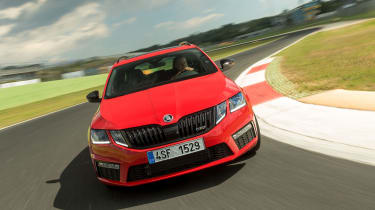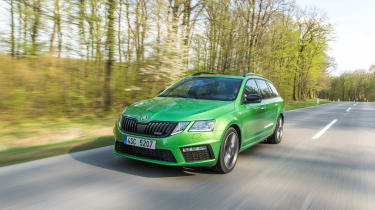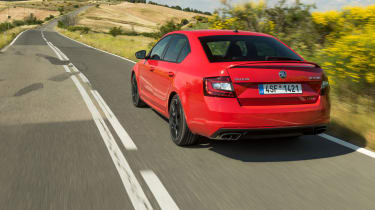Skoda Octavia vRS (2014-2019) review - ride and handling
Not the most fun, but well-rounded and good value too
The vRS is less agile hot hatchback than the Golf GTI and Leon Cupra, cars with which the Octavia vRS shares so much. Instead, mostly thanks to its longer wheelbase, it’s more of an entertaining sports saloon. That’s not to detract from the Octavia’s abilities, more an observation that it doesn’t instantly feel as energetic as the current selection of performance hatchbacks.
In the family car role for which many Octavia vRS will be destined, that’s probably a good thing, though you’re never far from experiencing the car’s firm ride quality – particularly on the larger 19in alloy wheel option. It’s well-damped, particularly at speed, and always feels composed and fluid.
There’s plenty of grip; the XDS+ electronic diff helps provide plenty of that traction at the front. There’s still a nice balance to the chassis as there’s lots of grip across the rear axle, too. It feels very competent at making progress no matter the size of the road or the weather conditions.
The 4x4’s abilities were best demonstrated on our first acquaintance on a frozen lake. Driven normally – on Michelin Pilot Alpin winter tyres – it was unflappable, turning in safely and resisting loss of traction extremely well.
More reviews
In-depth reviews
Reviews
- Skoda Octavia vRS 2025 review – the ultimate accessible Q car?
- Skoda Octavia vRS iV plug-in hybrid 2020 review – eco stealth
- Skoda Octavia vRS Estate review
- Skoda Octavia vRS 245 review
- 2017 Skoda Octavia vRS review
- 2017 Skoda Octavia review - Facelifted hatch driven
- Skoda Octavia vRS 4x4 review - extra traction for extra fun?
Turn everything off, use more of the throttle pedal’s travel and more steering angle, and it isn’t long at all before you feel the Haldex system sending power rearwards. All very silly and great fun, but also a good demonstration of how the system redistributes power.
The vRS 245 gets an electronically controlled mechanical diff. When we tried the car on track it was possible to have both front tyres spinning and the car pushing into understeer. However, once you’ve become familiar with the car’s limits you can be more measured with your inputs, pushing the front tyres right to their limits. The 245 informs you of what’s going on between the tyres and the tarmac enough for you to judge just how much steering and throttle you can apply.
There isn’t the hyperactive, fidgety rear axle that some of the very best front-wheel drive performance cars are armed with, as such there’s not much in the way of corner entry or mid-corner adjustability and it remains admirably stable.
On the road its feels equally secure, yet there’s still enough feel and information transmitted through the steering and chassis for you to drive the 245 close to its limits. So, although you aren’t constantly tweaking your line with the throttle or correcting hints of oversteer, it’s still an involving and fun car to drive quickly.




